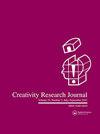Empirics vs. art theory: Exploring a factor structure of pictorial expression based on contemporary artworks
IF 3.1
3区 心理学
Q2 PSYCHOLOGY, EDUCATIONAL
引用次数: 0
Abstract
ABSTRACTThe RizbA scale combines psychometrics and art theory and enables a measurement of pictorial expression. This study explores its factor structure and a potential gap between theory and empirics. A sample of 275 pictorial works by artists and nonprofessionals was rated by 179 art experts. Three CFA path models were specified: models A and B based on the empirical results of previous studies, C on the theory of the initial study. Model C was additionally tested on a combined dataset. A and B did not converge, C was associated with fit indices as follows: RSMEA = .122, CFI = .712, TLI = .679, SRMR = .135, for the combined dataset: RSMEA = .086, CFI = .740, TLI = .696, SRMR = .084. Only model C partly suggests an acceptable fit. The results speak to a methodological gap between empirics and theory, that might be solved by a postdisciplinary measurement model.KEYWORDS: art theoryconfirmatory factor analysisformal picture analysispictorial expressionvisual art AcknowledgmentsThe authors gratefully acknowledge Thomas Gengenbach for providing theoretical and practical support regarding IT. Thanks also to Rebecca Kahn for the feedback on the manuscript.Disclosure statementNo potential conflict of interest was reported by the author(s).Ethics approvalThe authors received a positive vote of the Ethics Committee for Creative Arts Therapies at the Nürtingen-Geislingen University, Germany (Reference number 19C27J101W).Abbreviations API=Application programming interfaceCFA=Confirmatory factor analysisCFI=Comparative fit indexdf=Degrees of freedomMLE=Maximum likelihood estimateMLR=Robust maximum likelihood estimatorPAFA=Principal axis factor analysisPCA=Principal component analysisPHP=PHP: Hypertext PreprocessorRizbA=(Rating instrument for two-dimensional pictorial works) Ratinginstrument für zweidimensionale bildnerische ArbeitenRMSEA=Root mean square error of approximationSRMR=Standardized root-mean-square residualTLI=Tucker-Lewis Index经验主义与艺术理论:以当代艺术作品为例,探索绘画表达的因素结构
【摘要】RizbA量表结合了心理测量学和艺术理论,实现了对绘画表达的测量。本研究探讨其因素结构及理论与实证的潜在差距。179名艺术专家对艺术家和非专业人士的275幅绘画作品进行了评分。提出了三种CFA路径模型:A、B模型基于前人研究的实证结果,C模型基于初步研究的理论。模型C在一个组合数据集上进行了额外的测试。A和B不收敛,C与拟合指数相关如下:RSMEA = .122, CFI = .712, TLI = .679, SRMR = .135,对于组合数据集:RSMEA = .086, CFI = .740, TLI = .696, SRMR = .084。只有模型C部分表明可以接受。研究结果表明,实证和理论之间存在方法论上的差距,这可能会通过学科后测量模型来解决。关键词:艺术理论,验证性因素分析,形式图像分析,图像表现,视觉艺术感谢作者感谢Thomas Gengenbach在IT方面提供的理论和实践支持。也感谢Rebecca Kahn对手稿的反馈。披露声明作者未报告潜在的利益冲突。作者获得了德国n rtingen- geislingen大学创造性艺术疗法伦理委员会(参考编号19C27J101W)的赞成票。缩写API=应用程序编程接口ecfa =验证性因子分析iscfi =比较拟合indexdf=自由度mle =最大似然估计atemlr =稳健最大似然估计pafa =主轴因子分析pca =主成分分析PHP=PHP:超文本预处理器rizba =(二维图像作品的评级工具)评级工具 rzweidimensionale bildnerische ArbeitenRMSEA=近似的均方根误差srmr =标准化均方根残差li =塔克-刘易斯指数
本文章由计算机程序翻译,如有差异,请以英文原文为准。
求助全文
约1分钟内获得全文
求助全文
来源期刊

Creativity Research Journal
Multiple-
CiteScore
5.10
自引率
7.70%
发文量
52
期刊介绍:
Creativity Research Journal publishes high-quality, scholarly research capturing the full range of approaches to the study of creativity--behavioral, clinical, cognitive, crosscultural, developmental, educational, genetic, organizational, psychoanalytic, psychometrics, and social. Interdisciplinary research is also published, as is research within specific domains (e.g., art, science) and research on critical issues (e.g., aesthetics, genius, imagery, imagination, incubation, insight, intuition, metaphor, play, problem finding and solving). Integrative literature reviews and theoretical pieces that appreciate empirical work are extremely welcome, but purely speculative articles are not published. Readers are encouraged to send commentaries, comments, and evaluative book reviews.
 求助内容:
求助内容: 应助结果提醒方式:
应助结果提醒方式:


